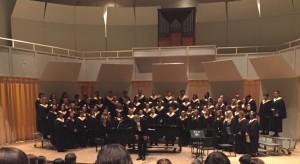
Michael Lancaster, director, takes a bow after University Chorus finishes their last song. Photo by Julia Hudgins.
Western Carolina University hosted its Fall Choral Concert on Oct. 29 in the Coulter Recital Hall.
Community members, family, friends and fellow students gathered to see the University Chorus, Early Music Ensemble, and the Concert Choir each perform their own set of songs. The concert was directed by Michael Lancaster, associate professor and Director of Choral Activities and was accompanied by Ann Tiner.
The evening started with music from University Chorus, which was by far the biggest of the groups that performed with 74 members. They performed five songs, two of them in different languages which proved a challenge for some of the members of the choir.
“The hardest piece to learn [for me] was a piece called ‘Yo paso las noches’ mostly because of the Spanish lyrics,” Caleb Dunn, tenor and member of University Chorus, said. He added that the choir practiced three times a week for around twenty minutes to perfect their pieces for the concert.
Following the University Chorus on stage was the Early Music Ensemble, a much smaller group consisting of only nine members. The ensemble sang four songs created in the 16-th or 17-th century.
The final group of the night was the Concert Choir. Its 23 singers sang a set consisting of five songs, ranging from 300 year-old hymns to ballads from the 1970s. Tasha Davis, soprano and member of the Concert Choir, explained that one of the songs, “Come to Me, My Love,” was added to the concert at the last minute because of its success it had on the two-day tour the choir took the week before the concert, where they performed at six high schools, three in Charlotte and three in Asheville.
This song was popular among the audience at WCU as well.
“’Come to Me, My Love’ was my favorite. It was very beautiful, the melody at the beginning and just the sound of it. It had almost an R&B feel to it and I really liked that,” Tyler Jones, audience member and English major, said.
The Fall Choral Concert ended with all the groups coming together to perform “The Promise of Living” a song based off life in the Appalachian Mountains.


